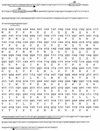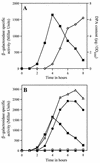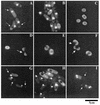Identification of a new gene essential for germination of Bacillus subtilis spores with Ca2+-dipicolinate
- PMID: 12644503
- PMCID: PMC151495
- DOI: 10.1128/JB.185.7.2315-2329.2003
Identification of a new gene essential for germination of Bacillus subtilis spores with Ca2+-dipicolinate
Abstract
Bacillus subtilis spores can germinate with a 1:1 chelate of Ca(2+) and dipicolinic acid (DPA), a compound present at high levels in the spore core. Using a genetic screen to identify genes encoding proteins that are specifically involved in spore germination by Ca(2+)-DPA, three mutations were identified. One was in the gene encoding the cortex lytic enzyme, CwlJ, that was previously shown to be essential for spore germination by Ca(2+)-DPA. The other two were mapped to an open reading frame, ywdL, encoding a protein of unknown function. Analysis of ywdL expression showed that the gene is expressed during sporulation in the mother cell compartment of the sporulating cell and that its transcription is sigma(E) dependent. Functional characterization of YwdL demonstrated that it is a new spore coat protein that is essential for the presence of CwlJ in the spore coat. Assembly of YwdL itself into the spore coat is dependent on the coat morphogenetic proteins CotE and SpoIVA. However, other than lacking CwlJ, ywdL spores have no obvious defect in their spore coat. Because of the role for YwdL in a part of the spore germination process, we propose renaming ywdL as a spore germination gene, gerQ.
Figures







Similar articles
-
Genetic requirements for induction of germination of spores of Bacillus subtilis by Ca(2+)-dipicolinate.J Bacteriol. 2001 Aug;183(16):4886-93. doi: 10.1128/JB.183.16.4886-4893.2001. J Bacteriol. 2001. PMID: 11466292 Free PMC article.
-
SwsB and SafA Are Required for CwlJ-Dependent Spore Germination in Bacillus subtilis.J Bacteriol. 2020 Feb 25;202(6):e00668-19. doi: 10.1128/JB.00668-19. Print 2020 Feb 25. J Bacteriol. 2020. PMID: 31871031 Free PMC article.
-
Regulation and characterization of a newly deduced cell wall hydrolase gene (cwlJ) which affects germination of Bacillus subtilis spores.J Bacteriol. 1998 Mar;180(6):1375-80. doi: 10.1128/JB.180.6.1375-1380.1998. J Bacteriol. 1998. PMID: 9515903 Free PMC article.
-
How do spores germinate?J Appl Microbiol. 2006 Sep;101(3):526-30. doi: 10.1111/j.1365-2672.2006.02885.x. J Appl Microbiol. 2006. PMID: 16907803 Review.
-
Recent progress in proteins regulating the germination of Bacillus subtilis spores.J Bacteriol. 2025 Feb 20;207(2):e0028524. doi: 10.1128/jb.00285-24. Epub 2025 Jan 8. J Bacteriol. 2025. PMID: 39772627 Free PMC article. Review.
Cited by
-
Dynamic patterns of subcellular protein localization during spore coat morphogenesis in Bacillus subtilis.J Bacteriol. 2004 Jul;186(14):4441-8. doi: 10.1128/JB.186.14.4441-4448.2004. J Bacteriol. 2004. PMID: 15231775 Free PMC article.
-
Structural characterization of inhibitors with selectivity against members of a homologous enzyme family.Chem Biol Drug Des. 2012 Jan;79(1):128-36. doi: 10.1111/j.1747-0285.2011.01267.x. Epub 2011 Nov 28. Chem Biol Drug Des. 2012. PMID: 22039970 Free PMC article.
-
The Exosporium Layer of Bacterial Spores: a Connection to the Environment and the Infected Host.Microbiol Mol Biol Rev. 2015 Dec;79(4):437-57. doi: 10.1128/MMBR.00050-15. Microbiol Mol Biol Rev. 2015. PMID: 26512126 Free PMC article. Review.
-
The germination-specific lytic enzymes SleB, CwlJ1, and CwlJ2 each contribute to Bacillus anthracis spore germination and virulence.J Bacteriol. 2009 Sep;191(18):5569-76. doi: 10.1128/JB.00408-09. Epub 2009 Jul 6. J Bacteriol. 2009. PMID: 19581364 Free PMC article.
-
Contrasting evolutionary patterns of spore coat proteins in two Bacillus species groups are linked to a difference in cellular structure.BMC Evol Biol. 2013 Nov 27;13:261. doi: 10.1186/1471-2148-13-261. BMC Evol Biol. 2013. PMID: 24283940 Free PMC article.
References
-
- Bagyan, I., L. Casillas-Martinez, and P. Setlow. 1998. The katX gene, which codes for the catalase in spores of Bacillus subtilis, is a forespore-specific gene controlled by σF, and KatX is essential for hydrogen peroxide resistance of the germinating spore. J. Bacteriol. 180:2057-2062. - PMC - PubMed
Publication types
MeSH terms
Substances
Grants and funding
LinkOut - more resources
Full Text Sources
Other Literature Sources
Molecular Biology Databases
Miscellaneous

